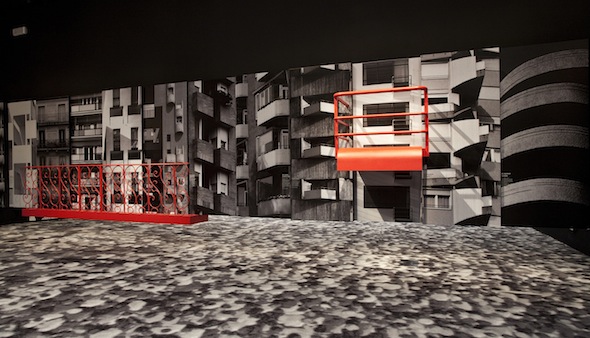 Elements of Architecture: balcony, installation view Central Pavilion, 14th International Architecture Exhibition, Fundamentals; courtesy la Biennale di Venezia, photo by Francesco Galli
Elements of Architecture: balcony, installation view Central Pavilion, 14th International Architecture Exhibition, Fundamentals; courtesy la Biennale di Venezia, photo by Francesco Galli
Article by Marcus Owens in Venice; Friday, Jul. 18, 2014
On display through November 23rd, the 14th Architecture Biennale in Venice has received significant attention due to director Rem Koolhaas’s penchant for showmanship and a sort of provocation and quasi-polemic that stays safely within the realm of social acceptability and the general status quo. Koolhaas’s organizing theme of “fundamentals” bears a clear lineage from past curatorial projects, such as his 2011 Cronocaos at New York’s New Museum. This connecting thread is Koolhaas’s bemoaning the declining stature of the architect from visionary public intellectual to a brand, a stooge of private capital. In an attempt to turn away from contemporary ‘starchitect’ culture, Koolhaas’s research team at OMA, complemented by a two-year engagement with students from the Harvard Graduate School of Design, identified various “elements” of architecture such as “wall,” “corridor,” “balcony,” “toilet,” “used by any architecture, anytime, anywhere.” As a sort of distillation to some pure state, these elements serve as a skeleton for “distancing from contemporary architecture” and, seemingly in a reference to Bernard Rudofsky’s 1964 MoMA Exhibition, an attempt to showcase “architecture, not architects.”
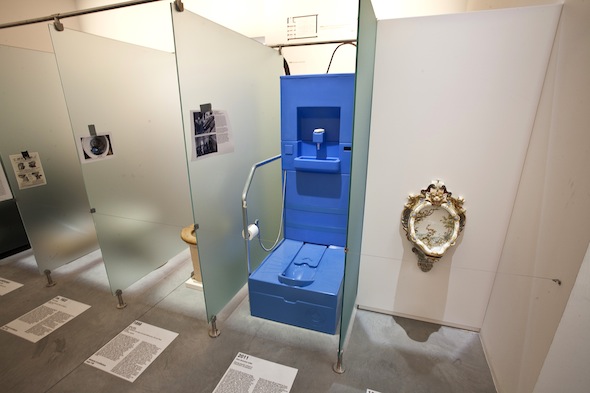 Elements of Architecture: toilet, installation view Central Pavilion, 14th International Architecture Exhibition, Fundamentals; courtesy la Biennale di Venezia, photo by Francesco Galli
Elements of Architecture: toilet, installation view Central Pavilion, 14th International Architecture Exhibition, Fundamentals; courtesy la Biennale di Venezia, photo by Francesco Galli
Each element is accompanied by “evolution diagrams” that show how, for example, the fireplace evolved from a common pit or hearth into the various home appliances used for heating and cooking in the contemporary Western home. These diagrams are interesting, though there seems to be at once a somewhat arbitrary approach to what is termed an “element” and how such an element is investigated and dissected. In the case of the “stairs” element, we see featured the life’s work of Friedrich Mielke, the founder of the field of Treppenkunde, or Scalology.
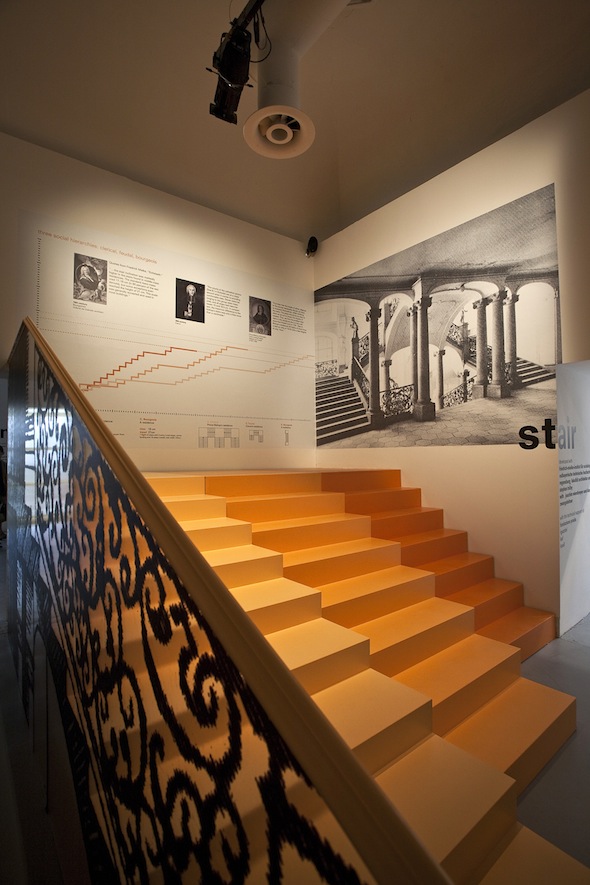 Elements of Architecture: stair, installation view Central Pavilion, 14th International Architecture Exhibition, Fundamentals; courtesy la Biennale di Venezia, photo by Francesco Galli
Elements of Architecture: stair, installation view Central Pavilion, 14th International Architecture Exhibition, Fundamentals; courtesy la Biennale di Venezia, photo by Francesco Galli
The chance to view treasures from Mielke’s personal collection is a true privilege. Unfortunately, not all “elements” are given the same rigor. To this end, a specter of eurocentrism and the discontents of the universalizing tendencies of the modernism for which Koolhaas seems nostalgic, can at times haunt the project. This is both in terms of the selection of what is considered an “element” (how universal is an escalator, really?), as well as for how it is dissected and presented.
To be sure, there are some strong signs of this criticality in the National Pavilions, where Koolhaas took the unprecedented step of engaging with the national curatorial teams, instructing them to collectively address the notion of “absorbing Modernity,” a seemingly violent process, compared to “absorbing blows” in a boxing match.
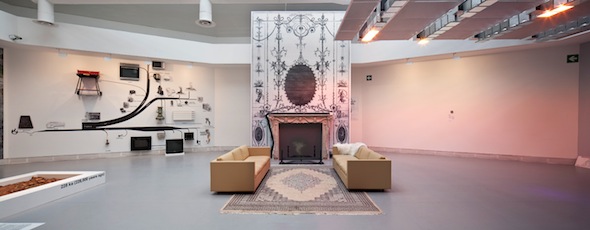 Elements of Architecture: fireplace, installation view Central Pavilion, 14th International Architecture Exhibition, Fundamentals; courtesy la Biennale di Venezia, photo by Francesco Galli
Elements of Architecture: fireplace, installation view Central Pavilion, 14th International Architecture Exhibition, Fundamentals; courtesy la Biennale di Venezia, photo by Francesco Galli
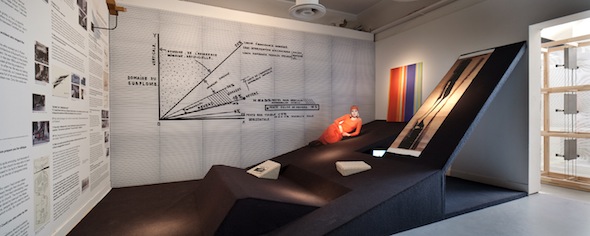 Elements of Architecture: ramp, installation view Central Pavilion, 14th International Architecture Exhibition, Fundamentals; courtesy la Biennale di Venezia, photo by Francesco Galli
Elements of Architecture: ramp, installation view Central Pavilion, 14th International Architecture Exhibition, Fundamentals; courtesy la Biennale di Venezia, photo by Francesco Galli
Nevertheless, Koolhaas’ attempt to move away from the culturally and historically bounded profession of architecture and towards a universal “architecture” is fraught with other hazards. In terms of tactics and methods, the encroachment into the realms of anthropology and geography does not always play into the strengths of architecture. In one instance, in what was one of the more rigorously researched installations, viewers are presented A4 print outs of Stephan Trüby’s doctoral dissertation, Die Geschichte des Korridors. If one has the time, no doubt a fascinating subject: although I’m not sure standing in the midst of the Venice Biennale is the time or place for reading doctoral dissertations or watch documentary films.
Despite what can therefore seem like walking into a Rem Koolhaas wikipedia wormhole for a few hours, it makes for a nonetheless widely accessible and interesting show, that may leave some visitors wishing for a bit more. Luckily, there are books for purchase…
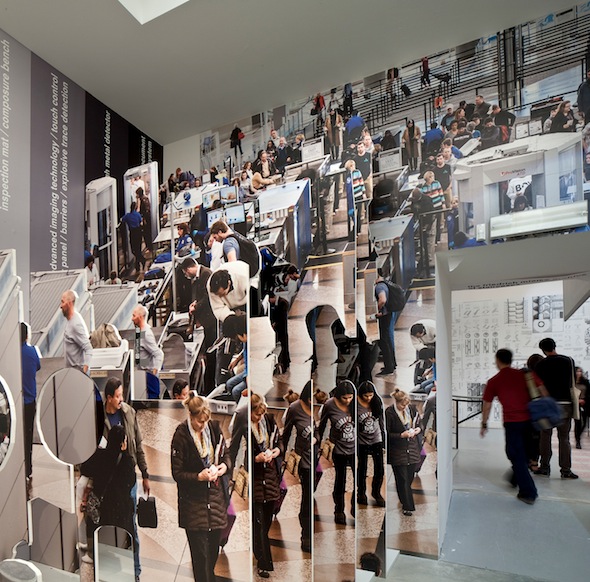 Elements of Architecture: door, installation view Central Pavilion, 14th International Architecture Exhibition, Fundamentals; courtesy la Biennale di Venezia, photo by Francesco Galli
Elements of Architecture: door, installation view Central Pavilion, 14th International Architecture Exhibition, Fundamentals; courtesy la Biennale di Venezia, photo by Francesco Galli
___________________________________________________________________________________
Additional Information
14th International Architecture Exhibition
“Fundamentals”
Exhibition: Jun. 07 – Nov. 23, 2014
Giardini and Arsenale, Venice, Italy
___________________________________________________________________________________
Marcus Owens is an architect born in Washington DC. Follow him on instagram at markuse_o.



















